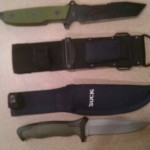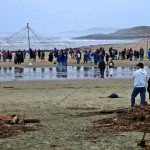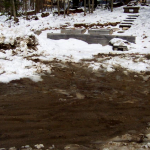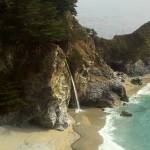We are approaching the Lughnasadh season, and bulls are on my mind. We have several large standing stones on our ridge–the thick, curved variety. One of my neighbors recently mentioned a bit of local folklore about these stones. In this townland of east Cork, those large stones are known as ‘bull stones’. Our neighbor said that when she was a girl she thought this was because they tied the bull to them….
On the Dingle Peninsula a great assembly was held on Domhnach Chrom Dubh in the village of Cloghane. In the old days, the turas (pilgrimage) was made at dawn on the top of Mount Brandon–which would have required a night climb or a vigil on the hill (1). The ’rounds’ consisted of praying at the ruined oratory (Sáipéilín Bréanainn) and then encircling it and the pillar-stone and the ‘graves’ nine times while saying the Rosary, and ended by taking a drink from the well.
 When these exercises finished, pilgrims went down the eastern slope to the village, where a famous Patron was held. This Patron was begun, tradition says, to commemorate the day on which the pagan chieftain Crom Dubh converted to Christianity. Crom lived at Ballyduff (Baile Dubh), about two miles from Cloghane. A stone carving, formerly kissed as a cure for toothache, in the wall of a local church is said to represent his head. In the OS Name Books for this parish, dated 1841, there is a note indicating that Croum Dhu was the god of the harvest whom pagans worshipped. His conversion legend tells of him slaughtering a bull in order to send the meat as a gift to St. Brendan.
When these exercises finished, pilgrims went down the eastern slope to the village, where a famous Patron was held. This Patron was begun, tradition says, to commemorate the day on which the pagan chieftain Crom Dubh converted to Christianity. Crom lived at Ballyduff (Baile Dubh), about two miles from Cloghane. A stone carving, formerly kissed as a cure for toothache, in the wall of a local church is said to represent his head. In the OS Name Books for this parish, dated 1841, there is a note indicating that Croum Dhu was the god of the harvest whom pagans worshipped. His conversion legend tells of him slaughtering a bull in order to send the meat as a gift to St. Brendan.
Another story, this one from Galway, recounts how Crom Dubh (‘a false god whose law prevailed until Patrick overcame him’) was a wild speckled bull (tarbh breac) that killed travelers at Mam Ean: it attacked Patrick, but was driven by him into the lake in which it drowned (Loch an Tairbh – the bull’s lake). In Armagh there is the story of a bull that prevented Patrick from building a church, so Patrick cursed him and he went mad, was eventually caught and killed, and buried under a standing stone at Corran. This stone, part of The Bull’s Tracks, was once associated with the bull of Cualgne (from the Cattle Raid of Cooley), which makes sense because originally the bull that defied Patrick (Crom) and the bull of Cualgne were, if not one and the same, at least emanations of the same concept.
 On an island north of Skye there was a tradition of sacrificing a bull in August, on a day dedicated to ‘going around some ruinous chapels, taking of omens from a hole in a round stone…, adoring of wells and … pouring of milk upon hills as oblations.’ – and the bull-killing associated with a cure for insanity(2). From Cois Fhairrge, we hear of a beef-animal skinned and roasted to ashes in honour of Crom Dubh (harvest-giver and weather-ruler), with the hide carefully preserved. For as we know from many Irish sources, sleeping in a bull-hide was a rite of divination.
On an island north of Skye there was a tradition of sacrificing a bull in August, on a day dedicated to ‘going around some ruinous chapels, taking of omens from a hole in a round stone…, adoring of wells and … pouring of milk upon hills as oblations.’ – and the bull-killing associated with a cure for insanity(2). From Cois Fhairrge, we hear of a beef-animal skinned and roasted to ashes in honour of Crom Dubh (harvest-giver and weather-ruler), with the hide carefully preserved. For as we know from many Irish sources, sleeping in a bull-hide was a rite of divination.
I have read that a connection existed between the wild bull as guardian and dream giver, and an essential trial undergone by seekers. Bull sacrifice was also made to The Great Mother, whose temple in Rome is located under the Vatican.
There are several large stones identified as, or with, Crom Dubh (Crom Cruach, Cromm Crúaich, Cenn Cruach, Cenncroithi), i.e. the decorated stone from the Cavan stone circle, and the large stone at the Grange circle in Limerick.
 In a previous issue of the NRA archeology magazine, they say this about standing stones:
In a previous issue of the NRA archeology magazine, they say this about standing stones:
“Standing stones are thought to have functioned as burial-markers, commemorative monuments, boundmarkers and route indicators. … Previous excavations of standing stones in Ireland demonstrate a general association with prehistoric burial grounds and they are often interpreted as territorial markers. It has also been occasionally suggested that some are aligned on important landscape features such as local mountains. It has also been suggested that standing stones were intended to resemble the human form. The Ask stones may fall into one of two categories: ‘guardian’ stones to the site both warning of the entry into a sacred or supernatural space and protecting the outside world from the energies within, or ‘companion’ stones to the dead, marking the limits and extent of a sacred or significant place, such as a cemetery.”
Chrom, whose Holy Days are fast approaching, was associated here in Ireland with thunderstorms. It was said to be propitious if it lashed rain, with thunder and lightning, on his day. The development of thunderstorms requires warm air, which in turn would have meant good growing weather. But what was the significance to a pre-agrarian population who worshiped the Wild Bull? I don’t know. But I can tell you this….
We have had a true summer this year in Cork, and last night….. lightning flashed across the sky and thunder rolled. Long live Chrom!
1. Manuscript of the Irish Folklore Commission 888, 390.

















